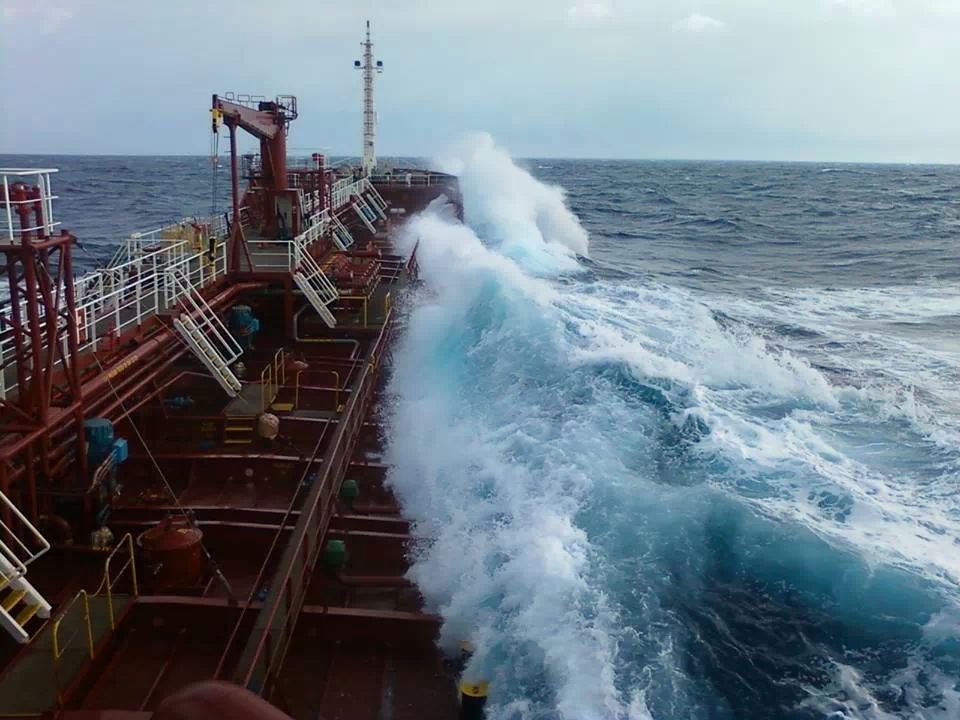Rogue wave photo taken from the deck of the RV Cape Henlopen in the
western North Atlantic during the Atlantic Remote Sensing Land/Ocean
Experiment (ARSLOE)
The crest of the rogue propogates from the right to
left.
Credit: H. Mitsuyasu
From UM Rosenstiel
University of Miami Rosenstiel School of Marine and Atmospheric Science scientist Mark Donelan and his Norwegian Meteorological Institute colleague captured new information about extreme waves, as one of the steepest ever recorded passed by the North Sea Ekofisk platforms in the early morning hours of Nov. 9 2007.
Photo by Sohit Sukla
Within the first hour of the day, the Andrea wave passed by a four-point square array of ocean sensors designed by the researchers to measure the wavelength, direction, amplitude and frequency of waves at the ocean surface.
Aerial view from southwest (elevation 45 degrees) of the reconstructed Andrea wave.
The colorbar indicates surface elevation. Vertical exaggeration is seven.
The blue dot (location: 0,0) indicates the observed crest of 14.97 m above MSL; the red dot indicates the reconstructed maximum crest height of 15.33 m at location: 14 m West, 6 m North.
The crest was advancing to the SSE (164 degrees) at 17.85 m/s.
Using the information from the wave set—a total of 13,535 individual waves—collected by the system installed on a bridge between two offshore platforms, the researchers took the wave apart to examine how the components came together to produce such a steep wave.
The data from the 100-meter wide “wall of water” moving at 40 miles per hour showed that Andrea may have reached heights greater than the recorded height of 49 feet above mean sea level.
They also found that rogue waves are not rare as previously thought and occur roughly twice daily at any given location in a storm.
The findings showed that the steeper the waves are, the less frequent their occurrence, which is about every three weeks at any location for the steepest rogues.
Surface elevation of groups in each period band displayed on axes of time and logarithm of period in seconds.
All 32 periods are displayed and their sum (divided by 20) is graphed along the time axis.
The Andrea crest is at 862 s.
Credit: Donelan, et.al.
Optimal focusing of the Andrea wave showed that the crest could have been even higher and limited by breaking at 1.7 times the significant height.
A 100-foot wave hits a ship in the North Sea, during an intense storm.
Had the ship been much smaller it could have been catastrophic, but the ship managed to withstand the blow.
“Rogue waves are known to have caused loss of life as well as damage to ships and offshore structures,” said Mark Donelan, professor emeritus of ocean sciences at the UM Rosenstiel School. “Our results, while representing the worst-case rogue wave forecast, are new knowledge important for the design and safe operations for ships and platforms at sea.”
The study, titled “The Making of the Andrea Wave and other Rogues,” was published in the March 8 issue of the journal Scientific Reports.
The authors include: Donelan and Anne-Karin Magnusson from the Norwegian Meteorological Institute.
The work was partly performed within the ExWaMar project (ID 256466/O80) funded by the Norwegian Research Council.
ConocoPhillips provided the wave data.
Links :
- GeoGarage blog : 19-meter wave sets new record - highest significant wave ... / How rogue waves are created in the ocean ... / Rogue wave prediction tool developed / Rogue wave theory to save ships / Science investigates freak waves / The Power of the SEA: tsunamis, storm surges, rogue waves, and our ...
- YouTube : New Zealand naval ship smashed by monster waves in Southern Ocean / Freakwave of 30 meters high

Lottery winners are never described as rogue winners, even though it is a rare event for the individual.
ReplyDeletePerhaps more accurate language will encourage vigilance at sea and beach. Peak waves?
Marine Insight : Effects of Rogue Waves On Ships
ReplyDelete